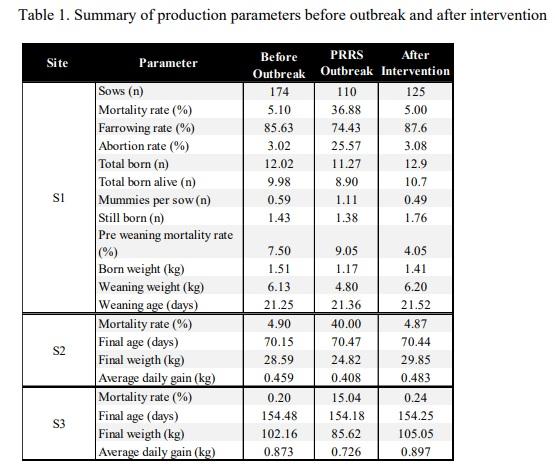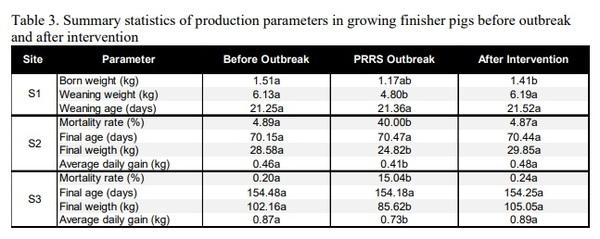A double intervention to stabilize Porcine Reproductive and Respiratory Syndrome - PRRS in a one site farm with continuous flow
Published: November 15, 2021
By: Mishelle Moral Romero 1, Juan Peralvo Vidal 1, Eduardo Rosa Medina 2, Jorge Campos Loyola 3, Marco Coral Almeida 4, Jorge Garrido Mantilla 2 / 1 Trouw Nutrition LATAM; 2 University of Minnesota; 3 Universidad Científica del Sur; 4 Universidad de la Américas.
Introduction
Porcine Reproductive and Respiratory Syndrome (PRRS) is the most relevant infectious disease in the swine industry. PRRS virus (PRRSv) live inoculation has been used to stabilize and even eliminate PRRS in positively confirmed farms. Batch farrowing is a production system used to maximize productivity and could be used to interrupt disease transmission in susceptible populations. This report captures the stabilization of a one site farm with a continuous production flow by virus inoculation and implementation of batch farrowing management.
Methods
In 2018, a commercial farm (200 sows per year) experienced reproductive and respiratory problems in both sows and growing finisher pigs (PRRS positive by ELISA). Serum samples were randomly collected from 35 days old piglets with acute clinical signs to confirm PRRS infection by ELISA. PRRS positive serum was used to amplify the PRRSv in 21 days old piglets, these pigs were euthanized and bled to harvest serum to be used as PRRSv inoculum. 1 ml of serum titrated to 103 PRRSv /ml was inoculated by muscular injection the whole herd. Simultaneously, a batch farrowing system was implemented in groups of three. The pig production flow was moved into another barn within the same farm emptying the nursery area. All-in all-out, washing and disinfection processes were implemented along with McREBEL1 procedures in all farrowing rooms to avoid transmission. Herd closure for 40 weeks was established. PRRSv surveillance was implemented throughout and after the herd closure following the AASV recommendations. Differences in production parameters between periods were assessed using paired samples t-test, repeated measures ANOVA and post-hoc Tukey test, significance level was established at p<0.01.
Results and Conclusions
PRRSv circulation was present before intervention. After PRRSv inoculation compatible clinical signs with infection were observed, including 12.2% abortion. Three batch farrowing groups were successfully implemented with 15 sows / group. Summary of the production results is shown in table 1 and summary statistics is presented in table 2 and 3. Farrowing rate decreased from 85.63% to 74.43% (p<0.01) during the PRRS outbreak, after the intervention the farrowing rate increased to 87.6% (p<0.01). After intervention, the abortion rate decreased from 25.57% to 3.08% (p<0.01), this recovery reached similar levels than before the outbreak. In addition, total number of piglets born alive increased from 8.89 to 10.7 (p<0.01), this increment was higher than before the outbreak; wean to finish mortality rate decreased from 55% to 5.11% (p<0.01); ADG increased from 726 g to 897 g (p<0.01). Finally, PRRSv PCR tests were consistently negative in four consecutive sampling processes after PRRSv inoculum.
A significant production improvement was obtained after the implementation of live PRRSv inoculation and the implementation of the batch farrowing system. Moreover, after 40 weeks of herd closure, the PRRSv circulation was eliminated. Immunity development by inoculation and interruption of PRRSv transmission by modification of epidemiological subpopulation might be the main reasons to obtain these results. Altogether, this report shows that virulent PRRSv infection can be controlled in a one site farm with a continuous production flow.



Presented at the 2021 Allen D. Leman Swine Conference and reproduced here with permission from the authors.
References
1. McCaw MB. MCREBEL PRRS: management procedures for PRRS control in large herd nurseries. Proc AD Leman Swine Conf: St. Paul MN; 1995. pp. 161–162.
Related topics
Authors:
Trouw Nutrition
Pathway Intermediates
Universidad de las Américas - Ecuador
Pipestone
Show more
Influencers who recommended :
Young Chul JungRecommend
Comment
Share

Would you like to discuss another topic? Create a new post to engage with experts in the community.









.jpg&w=3840&q=75)